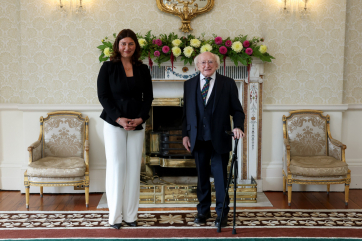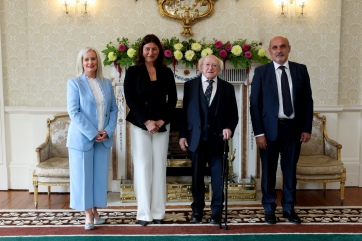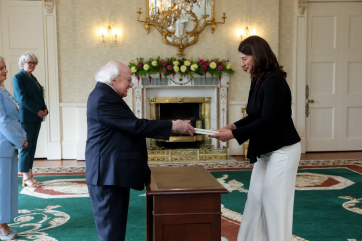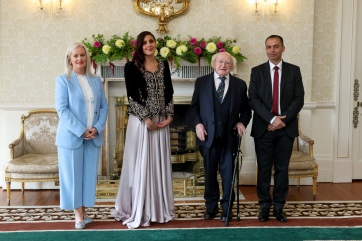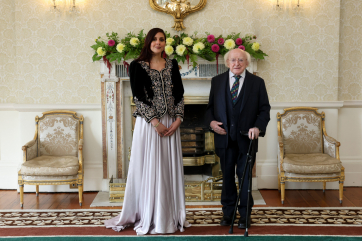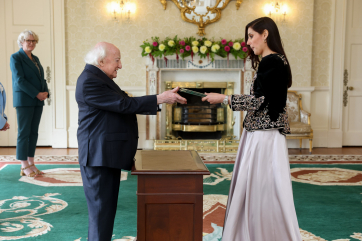Speech by President Michael D. Higgins Opening of the 2025 Fleadh Cheoil na hÉireann
Wexford Town, Sunday, 3rd August, 2025
A dhaoine uaisle,
A chairde Gael,
Ar mo shon fhéin agus ar son mo bhean chéile Saidhbhín, gabhaim buíochas libh as an fíor chaoín fáilte a d’fhearadh sibh romhainn. Tá áthas orainn a bheith libh inniu don tarna bhliain den Fleadh Cheoil na hÉireann i mbaile álainn Loch Garman.
Is í seo an uair dheireanach agam mar Uachtarán na hÉireann an Fhleadh Cheoil a oscailt go hoifigiúil, féile a chuireann gliondar ar mo chroí agus ar chroíthe an phobail anseo sa bhaile agus thar sáile.
Fleadh Cheoil na hÉireann is such a significant and special event in Ireland’s cultural calendar, a time to celebrate our rich musical heritage and traditions, a time when we come together from all over the island and welcome so many visitors from around the world who have come to celebrate with us our Irish music, song, dance and language, that vibrant tapestry of traditional Irish culture that has been woven over centuries.
Cuireann an Fhleadh Cheoil ardán ar fáil do na traidisiúin chultúrtha arb iad foinse ár n-Éireannachas a chosaint agus a chur chun cinn. Cothaíonn na traidisiúin chultúrtha seo spiorad an pobail agus spreagann sé daoine óga le bheith páirteach ann. Cruthaíonn an Fleadh Cheoil spás do chomórtais agus do mhalartú cultúir.
Travelling to various towns and cities across Ireland, Fleadh Cheoil na hÉireann has grown incrementally over the years from its beginnings as a one-day festival in 1951 in Mullingar. First organised by Comhaltas Ceoltóirí Éireann, and attended by just a few hundred people, it has become the grand week-long event that we celebrate today.
Last year’s event in Wexford was the largest to date, with up to 650,000 people visiting Wexford Town over the course of the eight-day festival. This included 20,000 performers, 7,000 of whom were competitors. The reviews from hardened Fleadh-goers, from all over the world, were outstanding.
Another number that stands out was the world record that was set at Fleadh Cheoil 2024, with 2,500 tin whistles playing simultaneously at Wexford Park, providing quite the sonic experience of such a rich and layered tin whistle chorus.
The atmosphere here in Wexford is always so welcoming. The combination of Wexford’s expansive quay-front and narrow medieval streets proved a huge hit last year. Wexford acquitted itself so well, and Wexford County Council is to be commended again this year for all its preparation and for keeping the streets of the town looking beautiful despite the huge crowds.
Ar ndóigh, teastaíonn iarracht mhór phleanála, chomh maith le díograis agus tiomantas, chun ócáid mar an Fhleadh Cheoil a eagrú. Ba mhaith liom tréaslú leo siúd a d’oibrigh gan stad chun rath na hócáide a chinntiú.
Tá muid ar fad in ann sásamh a bhaint as seachtain iomlán de cheiliúradh a bhuíochas do Labhrás Ó Murchú, do gach duine i gComhaltas Ceoltóirí Éireann, Coiste Feidhmiúcháin na Fleadh, Comhairle Contae Loch Garman, Fáilte Ireland agus an Comhar Creidmheasa, chomh maith le heagraíochtaí áitiúla, na gnólachtaí agus na hurraitheoirí.
An event like Fleadh Cheoil na hÉireann, of course, requires enormous planning, dedication and commitment. May I congratulate all those who have worked tirelessly behind the scenes to make this event possible. To Labhrás Ó Murchú and all in Comhaltas Ceoltóirí Éireann, the Fleadh Executive Committee, Wexford County Council, Fáilte Ireland, the Credit Union, local organisations, businesses, sponsors – it is thanks to your efforts, support and hard work that we are all able to enjoy this week of celebration.
The over 1,000 Fleadh volunteers underpin and make possible both the Fleadh Cheoil and Comhaltas Ceoltóirí Éireann. Volunteers who, in an exemplary spirit of active participation, willingly give their time, skills and experience to their community, are contributing to an event that makes a profound offering to our culture, our society and our economy.
Ar an mhórócáid shuntasach chultúrtha seo nuair a thagann muid le chéile mar náisiún le muid féin a thumadh sa cheol agus sna hamhráin is fiú go mór dúinn machnamh a dhéanamh ar na cúiseanna a gcuireann muid, mar Éireannaigh, luach chomh mór sin ar ár gceol agus ar ár n-amhráin thraidisiúnta agus ar na cúiseanna go bhfuil an ceol fréamhaithe chomh domhain sin i gcultúr na nGael.
On significant cultural occasions such as the Fleadh Cheoil, when we come together as a nation to immerse ourselves in song and music, it is worthwhile reflecting on why it is that we Irish place, and have always placed, such a high cultural value on music, on our traditional song, and why music has become so deeply ingrained into our Irish culture.
Deirtear – agus is í an fhirinne í – gur cuid dínn féin ár gceol ach, ag anam céanna, gur leis an domhan mór é. Is cuid lárnach é dár bhféiniúlacht mar Éireannaigh an tábhacht agus an meas a léiríonn muid do chumadh ceoil agus amhrán agus ár dtoilteanas chun na huirlisí agus na teicnicí chomh maith le gach a bhaineann leis na foinn, an comhcheol agus na liricí a roinnt.
Indeed it has been said – and it is so true – that our music is of us, and yet it is of the world. The importance and respect that we give to our song-writing and our music, our willingness to extend the tools and techniques of melody, harmony, lyrics and form that lie behind so many great songs and pieces of music, is a defining feature of what we mean when we refer to our Irishness.
Is iad na hamhráin, an ceol agus an rince a chothaíonn an Gaelachas laistigh díobh féin do mhórán den dara glúin d’Éireannaigh. Cothaíonn sé nasc domhain, lán le mothúcháin, idir iad féin agus tír na muintire a chuaigh rompu, agus is ceangal cumarsáide agus féiniúlachta é idir Gaeil atá scaipthe ar fud na cruinne.
For many second-generation Irish, it is our music, our dance and our song that speaks to them of what they experience as their inner Irishness, creating such a profound and emotional link between them and the land of their forefathers, an important source of communication and identity for Irish people scattered across the world.
Of course there are also those many musicians without national or ethnic ties to Ireland who participate in Irish music and dance culture for the love of it. These members of what I might term our ‘affinity diaspora’ are so welcome to the Fleadh Cheoil, and we look forward to hearing their interpretations of Irish music and culture in the coming days.
Creidim freisin go gcuireann an ceol ar ár gcumas dul i mbun ceiliúrtha agus caointe, dul ag rince agus teacht le chéile. Ceadaíonn sé dúinn éalú ón leadrán agus athnuachan a dhéanamh orainn féin, dul lasmuigh fiú de na teorainneacha fisiciúla, agus tugann sé deis dúinn seasamh go bródúil lenár gcultúr sainiúil, uathúil féin.
I suggest too that it is through music that we are enabled to celebrate and to mourn, to dance and to sing, to come together, to let ourselves escape the mundane and achieve a renewal, perhaps even a transcendence, but also to be defiantly proud of our distinctive and unique culture.
Is uirlis chumhachtach é an ceol do thráchtaireacht shóisialta, chun tuairimí polaitiúla a chur in iúl, chun tacaíocht, agóid nó frithbheartaíocht a spreagadh agus chun dúshlán a thabhairt don status quo. Trí liricí na n-amhrán is féidir linn ár bhfuath agus ár ndéistin don chogaíocht a chur in iúl agus slí na síochána a mholadh, chomh maith le todhchaí chóir agus chothrom a éileamh do gach uile dhuine, díreach mar a rinne go leor de chumadóirí mór le rá na n-amhrán agus trúbadóirí an idéalachais anuas trí na glúnta.
Music can be a powerful tool for social commentary, articulating political views, mobilising support, protest and resistance and challenging the status quo. Through lyrics, we can express our disgust and abhorrence of war, advocate a peaceful path and an emancipatory and just future for all, just as so many of the great singer-songwriters and utopian troubadours have done through the ages.
The live performance is so important. A profound respect for both the performance and the performer is deep within the Irish consciousness. It is my firm belief that no amount of online social networking or virtual reality can come close to that sense of connection, intensity of feeling and emotion that comes from playing music together, and indeed as part of the wider arts and cultural events.
It is for all of these reasons that our traditional and contemporary music holds a profound significance for our nation. It is a vital part of our cultural expression, and it must be treasured, respected, preserved, nurtured, supported and enjoyed.
Tá stair an cheoil thraidisiúnta ceangailte go dlúth le stair agus le taithí na himirce, neadaithe i nósanna na gcéadta bliain agus – cé gur fhorbair sé agus gur athraigh sé – choinnigh sé fós an féiniúlacht féin dá fréamhacha agus a mhacalla cultúrtha, ní hamháin sa bhaile ach ar fud an domhain mhóir. Rinne sé sin a bhuíochas do stair fhada na himirce, go háirithe le linn thréimhse an Ghorta Mhóir, tráth ar fhág na sluaite Éireannach an tír seo lena n-aghaidh a thabhairt ar Mheiriceá agus ar áiteanna eile agus ar thug an oiread sin acu a gcuid ceoil agus scéalta leo.
The history of Irish traditional music is one that is deeply enmeshed in our migratory past and migrant experiences, rooted in centuries-old traditions, and while evolving and adapting, it has succeeded in retaining the unique essence of its roots and cultural resonance, not just at home but all over the world, drawing from a sense of place thanks to our long history of emigration, particularly during the time of An Gorta Mór when vast numbers of Irish people moved to the United States and elsewhere, when so many immigrants brought their music and their stories with them.
To all those people who have come to live with us in Ireland today your stories and your music are most welcome, providing, as they do, a rich contribution to our modern, diverse Ireland.
It is by respecting our language, culture and music that we are all the more strong, assured, and able to respect other music, other cultures, and other versions of history.
When we reflect on the resurgence of interest in traditional music since the middle of the last century, one thing for which we must all be grateful is the exceptional work of Comhaltas Ceoltóirí Éireann, the not-for-profit organisation founded in Mullingar in 1951, and to Sean Ó Riada in particular.
Ba é an gníomh a rinne Seán Ó Riada, nuair a bhunaigh sé an grúpa ceoil thraidisiúnta Ceoltóirí Chulainn, a rinne cóiriú nua ar cheol traidisiúnta nach raibh cloiste nó nár samhlaíodh roimhe sin, a spreag an comórtas cruthaitheach do ghrúpaí ceoil ag an bhFleadh Cheoil.
May I also recommend a brilliant 2014 Ó Riada memorial lecture by Aileen Dillane from UCC.
It was Sean’s establishing of the traditional music ensemble Ceoltóirí Chulainn, a group that offered musical arrangements of traditional music, something that had been previously unheard of, that would influence the subsequent creative grúpa ceoil competition at the Fleadh Cheoil.
In subsequent decades, the public appreciation of Irish music-makers and performers was only to grow, and is very much still with us, something to be celebrated.
Musicians and artists such as The Dubliners, Luke Kelly, Enya, Christy Moore, the Chieftains, Clannad, the Gloaming with Martin Hayes and Iarla Ó Lionáird, and many others have not only captured the hearts of millions but have also brought Irish music to the world stage, their contributions invaluable in keeping our musical traditions alive and in introducing them to new audiences globally.
Ba mhaith liom a dhearbhú arís mar Uachtarán na hÉireann chomh bródúil agus atá mé as domhan saibhir bríomhar an cheoil Ghaelaigh atá go mór faoi bhláth anois. Tá muid i gcroílár tréimhse fhíorchruthaitheach fad is a bhaineann sé lenár gceol – athbheochan sa cheol tíre agus an ghlúin óg spreagtha le suim sa cheol traidisiúnta agus iad ag dul i ngleic leis le díograis, paisean, cruthaitheacht agus cumas.
As President of Ireland, I would like to say, once more, how immensely proud I am of the rich and vibrant Irish traditional music scene that continues to flourish. We are in the midst of a deeply creative period in our music, a folk musical revival fuelled by a resurgence of interest among young people who are embracing and drawing on traditional music with enthusiasm, passion, creativity and talent.]
Amongst this week’s diverse line-up of more than 15,000 musicians, dancers, singers and storytellers from various communities across Ireland and beyond, are the inspirational virtuoso artists and the custodians of the traditions for the future, showcasing their skills, competing in various categories, participating in sessions and workshops, bringing, as they do, a fresh perspective to the music, blending tradition with innovation, and ensuring that our cultural heritage remains relevant and alive.
Is gné fhíorshuntasach amach is amach den Fhleadh Cheoil é an méid suime a chuireann an t-aos óg ann. Nach iad lucht bunaithe an Chomhaltais a bheadh fíorshásta an óige agus an bhríomhaireacht sin a fheiceáil mar thoradh ar a gcuid oibre!
The level of interest among young musicians is truly a remarkable feature of the Fleadh Cheoil. That youth and that vibrancy is something that the forefathers of Comhaltas would be so very pleased to see as an outcome of their early work.
Then there are the lifelong friendships that are formed during Scoil Éigse’s master classes and also between artists who may compete against each other but also continue to play together in the informal sessions that are part of the Fleadh, in addition to the Comhaltas weekly music classes that laid the footing for the vibrancy of the music today.
Maidir le teanga na nGael, beidh sí ar a compord sa spás cultúrtha seo le linn na seachtaine. Tá súil agam go mbeidh an Ghaeilge le cloisteáil mar theanga bheo go minic le linn na n-imeachtaí poiblí ag an bhFleadh Cheoil agus go príobháideach i gcomhrá na gceoltóirí. Molaim na daoine óga sin a n-éiríonn leo an teanga a chur chun cinn ar bhealaí úrnua.
As to our native Irish language, which sits comfortably in this cultural space, over the coming week, it is my hope that Irish as a living language will be heard frequently both publicly during Fleadh events and privately as musicians chat. I commend the young people who have achieved success in promoting the language in new ways.
Thar tréimhse ceithre bliana déag mar Uachtarán na hÉireann, chuir sé gliondar ar mo chroí an oiread sin daoine óga a chloisteáil ag úsáid ár dteanga dhúchais agus an oiread sin acu a labhair Gaeilge liom féin. Ba mhaith liom iarraidh ar gach aon duine a bhfuil Gaeilge acu iarracht a dhéanamh í a úsáid gach lá, cabhrú le daoine eile agus fiú mura bhfuil agat ach an ‘cúpla focal’ tabhair seans don teanga!
As President of Ireland, over the past 14 years it has given me such great pleasure to witness so many young people use our native language, and indeed the number of young people who have spoken Irish to me. May I suggest that those of us who have it try to use it every day, help others, and even if you only have a few words, give the language a chance.
Mar fhocal scoir, as we embark on the 2025 Fleadh Cheoil, let us revel in the beauty of Irish music, and celebrate this great aspect of our shared rich culture, the essence of Irishness in all its form. In doing so, may we forge lasting bonds that transcend borders and generations, as we come together to celebrate the enduring power of music.
Beir beannacht ‘s bain taitneamh as an bhFleadh.

